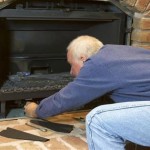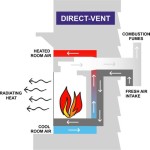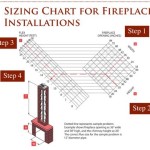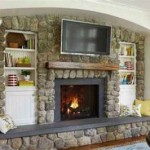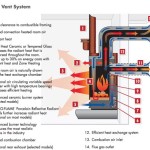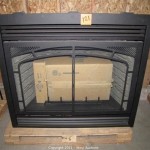Wood Burning Fireplace Surround: Aesthetics, Functionality, and Safety
A wood burning fireplace can serve as a focal point in any home, providing warmth, ambiance, and a connection to traditional heating methods. The fireplace surround, the decorative frame around the firebox, plays a crucial role in both the aesthetic appeal and functional safety of the fireplace. Selecting the appropriate wood burning fireplace surround requires careful consideration of materials, design, and adherence to safety regulations.
Material Selection for Wood Burning Fireplace Surrounds
The choice of material for a wood burning fireplace surround is paramount, impacting both the visual character and the fire resistance of the structure. Several materials are commonly employed, each offering distinct advantages and disadvantages. These materials include brick, stone, concrete, wood, and metal.
Brick is a classic choice, lauded for its durability, fire resistance, and inherent thermal mass. Brick surrounds can be configured in a variety of patterns, offering a wide range of aesthetic possibilities. The inherent weight of brick requires a solid foundation for support, making it a suitable option for new construction or renovations that can accommodate structural modifications. Brick is a relatively low-maintenance material, but its porous nature can make it susceptible to staining or discoloration over time. Sealing the brick can mitigate these issues, but periodic reapplication may be necessary.
Stone, like brick, offers excellent fire resistance and durability. Natural stone options, such as granite, marble, and slate, provide unique textures and color variations that can enhance the visual appeal of the fireplace. Stone surrounds can be incorporated in a variety of styles, from rustic and traditional to modern and minimalist. The weight of stone necessitates a strong supporting structure. Installation can be more complex and costly compared to other materials. Synthetic stone, or manufactured stone veneer, offers a lighter-weight and more affordable alternative. While synthetic stone mimics the appearance of natural stone, it may not possess the same level of durability or fire resistance.
Concrete is a versatile material that can be molded into a variety of shapes and textures. Concrete fireplace surrounds can be customized to achieve a specific aesthetic, from smooth and modern to textured and rustic. Concrete is fire resistant and relatively durable. The weight of concrete requires a solid foundation. Proper sealing is essential to prevent staining and moisture absorption. Concrete can be stained or painted to achieve a desired color scheme, offering further customization options.
Wood, while providing a warm and inviting aesthetic, requires careful consideration due to its inherent flammability. When using wood for a fireplace surround, it is crucial to adhere to strict clearance requirements specified by building codes and manufacturers. Non-combustible materials, such as brick or stone, should be used to create a buffer zone around the firebox. Wood mantels, often incorporated into fireplace surrounds, should be positioned at a safe distance above the firebox to prevent ignition. The wood used should be treated with a fire-retardant coating to enhance its fire resistance. Regular inspection and maintenance are essential to ensure the wood surround remains in good condition and poses no fire hazard.
Metal, particularly steel and cast iron, offers a modern and sleek aesthetic while providing excellent fire resistance. Metal surrounds can be fabricated in a variety of designs, from simple and minimalist to ornate and decorative. Metal is durable and relatively low-maintenance. However, it can be susceptible to rust or corrosion if not properly treated. Metal surfaces can become hot during fireplace operation, necessitating caution to prevent burns. Powder coating or other protective finishes can enhance the durability and appearance of metal fireplace surrounds.
Design Considerations for Wood Burning Fireplace Surrounds
The design of a wood burning fireplace surround should complement the architectural style of the room and reflect the homeowner's personal preferences. Several design elements should be considered, including the overall style, the size and proportions, the mantel, and any decorative accents.
The overall style of the fireplace surround should harmonize with the existing décor of the room. Traditional styles often feature ornate details, such as carved moldings, raised panels, and decorative tiles. Modern styles tend to be more minimalist, emphasizing clean lines, geometric shapes, and understated elegance. Rustic styles incorporate natural materials, such as rough-hewn wood or stacked stone, to create a warm and inviting atmosphere. Transitional styles blend elements of traditional and modern design, offering a balanced and versatile aesthetic.
The size and proportions of the fireplace surround should be appropriate for the size of the room and the scale of the firebox. A surround that is too large can overwhelm the space, while a surround that is too small can appear insignificant. The height and width of the surround should be carefully considered to create a balanced and visually pleasing composition. The proportions of the surround should also complement the dimensions of the mantel, if one is included.
The mantel, a shelf or ledge positioned above the firebox, serves as a focal point and provides a space for displaying decorative items. Mantels can be crafted from a variety of materials, including wood, stone, and metal. The style of the mantel should complement the overall design of the fireplace surround. The size and depth of the mantel should be appropriate for the size of the fireplace and the proportions of the room. Clearance requirements should be observed to ensure the mantel is positioned at a safe distance above the firebox.
Decorative accents, such as tiles, mosaics, or metal inlays, can enhance the visual appeal of the fireplace surround. Tiles can be used to create a decorative border around the firebox or to cover the entire surround. Mosaics offer a unique and artistic way to add color and texture to the fireplace. Metal inlays can provide a subtle touch of elegance and sophistication. The choice of decorative accents should complement the overall style of the fireplace and the décor of the room.
Beyond the aesthetic elements, proper ventilation and clearances are critical design considerations. The surround should not obstruct airflow to the firebox, ensuring efficient combustion and preventing overheating. Clearances to combustible materials, such as walls and furniture, must be maintained to prevent fire hazards. Building codes and manufacturer specifications should be consulted to ensure compliance with safety regulations.
Safety Regulations and Installation Considerations
Installing a wood burning fireplace surround requires strict adherence to safety regulations and building codes to ensure the safe and efficient operation of the fireplace. Proper installation is crucial to prevent fire hazards, carbon monoxide poisoning, and other potential safety risks.
Building codes and regulations vary depending on the location. Homeowners should consult with their local building department to determine the specific requirements for fireplace installations in their area. These codes typically address issues such as clearance to combustible materials, chimney construction, ventilation requirements, and fire safety standards. Failure to comply with these regulations can result in fines, delays, and potential safety hazards.
Clearance to combustible materials is a critical safety consideration. Combustible materials, such as wood walls, furniture, and draperies, should be positioned at a safe distance from the firebox to prevent ignition. The minimum clearance requirements are typically specified in building codes and manufacturer instructions. Non-combustible materials, such as brick, stone, or metal, can be used to create a buffer zone around the firebox, reducing the risk of fire hazards.
Chimney construction is another important aspect of fireplace safety. The chimney must be properly sized and constructed to ensure adequate draft and prevent the backflow of smoke and carbon monoxide into the home. The chimney should be inspected regularly for cracks, blockages, and other signs of damage. A qualified chimney sweep should be hired to clean and maintain the chimney on a regular basis. Carbon monoxide detectors should be installed in the home to provide early warning of any potential carbon monoxide leaks.
Professional installation is highly recommended for wood burning fireplace surrounds, especially for complex installations or when dealing with gas or electrical connections. Qualified contractors possess the knowledge, skills, and experience to ensure the fireplace is installed safely and correctly. They can also assist with obtaining the necessary permits and inspections. DIY installations can be risky and may not meet safety standards, potentially leading to hazardous situations.
Prior to installation, a thorough inspection of the existing fireplace and chimney should be conducted to identify any potential problems. This may include checking for cracks in the firebox, inspecting the chimney flue for obstructions, and assessing the structural integrity of the hearth. Any necessary repairs or upgrades should be completed before installing the new fireplace surround.
During installation, proper sealing and insulation are crucial to prevent air leaks and heat loss. Gaps and cracks around the fireplace surround should be sealed with fire-resistant caulk or sealant. Insulation can be added to the surround to improve energy efficiency and reduce heat transfer to surrounding materials. Proper ventilation should be maintained to ensure adequate airflow to the firebox.
Following installation, a final inspection should be conducted to verify that the fireplace is operating safely and efficiently. This may involve testing the draft of the chimney, checking for carbon monoxide leaks, and ensuring that all safety features are functioning properly. Homeowners should familiarize themselves with the proper operation and maintenance of their wood burning fireplace to ensure its continued safe and efficient performance.

Wooden Fire Surrounds White Fireplaces Oak Wm Boyle

Stovax Pembroke Wood Mantel

Fireplace Stone Marble Timber Surrounds Bonfire Fireplaces

Choosing A Fireplace Surround For Your Wood Burning Stove

Limestone Fireplaces For Wood Burning Multi Fuel Stoves Coal Gas Fires

Oak Beam Fireplace Surround Celtic Timber

20 Ideas To Decorate Around A Wood Burning Stove

Fireplaces Coventry Stoves And

Fireplace Surround Ideas Choosing The Right Mantel

How To Build Install A Fireplace Mantel We Love Fire
Related Posts

